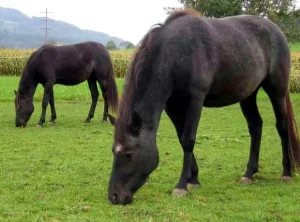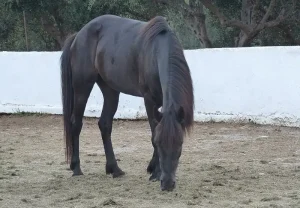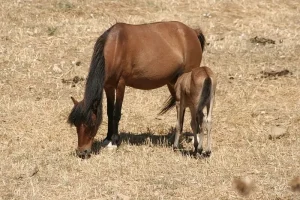
Donkeys and Other Breeds
May 11, 2023
Dogs and family or companion dogs
May 11, 2023Horses were first domesticated in the Eurasian Steppes during the 4th millennium B.C.E. and spread to and throughout the Near East and Mediterranean from there. In Greece, horses became important in life generally and especially in warfare, racing, traveling, and hunting.
1. Andravida
The Andravida horse is also known as Eleia or Ilia and is a rare light draft equine species originating from the region of Ilia in Greece.
Athenians used this breed’s ancestors as cavalry horses in the 4th century BC, mainly because they were smart, brave, and undemanding. The Greeks also used these large, sturdy, and robust horses for war in the 7th century.
As they became more famous for transport and carrying goods, breeders infused them with the Arabian blood to refine the stock into a lighter strain in the 13th–15th century. It was not until the early 20th century that the modern Andravida developed after crossing the Anglo-Norman breed with the Ilia’s local breeds and Nonius stallions.
However, the strain began declining and almost became extinct until 1990 when an Andravida stud bred nearly 50 healthy colts, saving the breed from depletion. The horse breed was featured in the official studbook for the first time in 1995, although the numbers are low today.
Features – Usually, the horse breed stands at an average height of 14-16 hands (56-64 inches). It is large and sturdy, with a distinct head, deep and masculine chest, and stocky, robust legs.
Colors – Black, brown, chestnut, bay, red-roan, and palomino
2. Arravani

Image Credit: Pottok at German Wikipedia, Wikimedia Commons
The early Greeks used the Arravani horse breed for agricultural work and transportation, making it a multipurpose animal.
This equine began in 1000 BC after crossing Dorian ponies and Thessalian horses in Peloponnese, Southern Greece. After that, Roman horses reached Greece around 146 BC, influencing the Arravani strain to produce a tough, surefooted breed with great temperaments.
Unfortunately, Greece’s industrial revolution led to modernization and motor vehicles’ introduction, causing the decline of these equines. Besides losing their place as transport and agricultural animals, exportation to Italy for meat led to a further reduction in numbers.
This breed faces extinction, with only almost 200-300 Arravanis remaining in the world today.
Features – The Arravani has an Arabian influence that gives it its refined elegance. It has a height of 12.3-14.6 hands (130cm-150cm), a small head, bold eyes, a highly-set neck, little hooves, and lush mane and tail.
Colors – Black, brown
3, Cretan

Image Credit: Tsaag Valren, Wikimedia Commons
The Cretan horse (Messara Horse) is a light draft equine found on the Crete island off Greece’s coast. It is a mountain-type horse species having existed in Crete since more than 1000 years ago.
The modern-day Cretan species were developed after foreign Turkish Arabian stallions were bred with mountain-type native mares on the Messara plain. Greeks used these horses mainly for breeding to produce hinnies, transport, and light farm duties.
These horses began declining during the First Great War after being moved to Albania, where most died. The number of Cretan horses came down from 6,000 in 1928 to almost 80 animals by the 1990s.
A conservation program began efforts to revive the breed started in 1994, the same year it featured in the studbook for the first time. Only about 100 Cretan horse breeds exist today.
Features – Like their Arabian ancestors, they are elegant, have a natural pacing gait, are comfortable to ride, and have an average height of 12.2-14 hands (50 inches -56 inches).
Color – Bay, brown, black, and grey
4. Peneia Pony
The Peneia pony is a rare horse breed originating from the Peloponnese in Southern Greece. Peneia is a translation of the “Peninsula pony” and is also known as Pinia, Panela, Pinela, or the Elis.
This breed’s roots link to the Pindos breeds before crossbreeding them with Anglo-Arabs, Anglo-Norman, and Nonius species. The establishment of its studbook happened in 1995.
According to the Greek Agriculture Ministry statistics, only 231 mares and 69 stallions existed as of 2002. Peneia ponies can work as a draft, sport, exhibition, pack, and breeding animals.
Features – They have a proportional head with a convex appearance, well-set neck, broad chest, short back, long neck, and muscular, sloping shoulders. However, the horses’ small but sturdy hooves give them a stilted natural gait.
Colors – Black, chestnut, bay, grey, black
5. Pindos Pony

Unknown Artist
The Pindos is a hardy, surefooted equine originating from Greece’s mountainous regions of Thessaly and Epirus. They are also known as the Thessalian pony and are of Asian lineage.
These horse’s hardiness and significant stamina make them suitable for riding, driving, and farming when used as a pack and draught animal. Plus, they are famous for breeding mules. However, only 464 mares and 81 Pindos stallions existed as of 2002.
Features – Pindos ponies have plump but well-shaped heads, lean necks, short and robust backs, with an average height of 132 cm. They don’t require shoeing thanks to the horse’s narrow, boxy, and hard hooves.
Color – Black, grey, and bay.
6. Skyros Pony

Image Credit: Andrew Frey-Lempicki, Wikimedia Commons
The Skyros pony is one of the most extinct horses globally, with roots tracing back to Southeast Skyros islands-where it acquired its name. Although its bloodline is unknown, the breed has been around for centuries serving as a farm and riding horses during summer seasons.
Skyros ponies are also the smallest Greek pony breeds and usually display spirited but social temperaments and more miniature horse-like characteristics than other ponies. They are also smart, friendly, and powerful.
Unfortunately, these horses went downhill after the onset of transport and farming mechanization, with only 220 Skyros living in Greece as of 2009.
Since they are endangered, societies like the Skyrian Horse Society and Skyros Island Horse Trust have beefed up conservation, breeding, and education in an attempt to restore and protect their bloodline.
Features – The Skyros pony is a small-bodied breed standing at only 9.1-11 hands (92 cm-112 cm). These species have large and beautiful heads, short necks, flat chests, straight backs, and long, thick manes. They also have slim, healthy, and wiry legs, a lowly set tail, small, compact, and sturdy hooves that do not need shoeing.
Color – Dun, grey, and bay
7. Zante
The Zante horses come from the Zante Islands in Greece and are the result of crossbreeding Greek horses with Anglo-Arab stallions.
They stand at 1.44-1.55 m and often appear in black. This horse breed is also known as the Zakynthian horse. However, it is among the unregistered Greek horse breeds.
8. Rodope Pony
Rodope pony breeds are among the rare and unregistered Greek horses. This ancient Greek breed traces its root to the Rhodope Mountains in Thrace, Greece.
The species is about 1.35 m high and has a cylindrical body. You can find the breed in roan grey, bay, and grey colors, with patterns on the head and legs.



